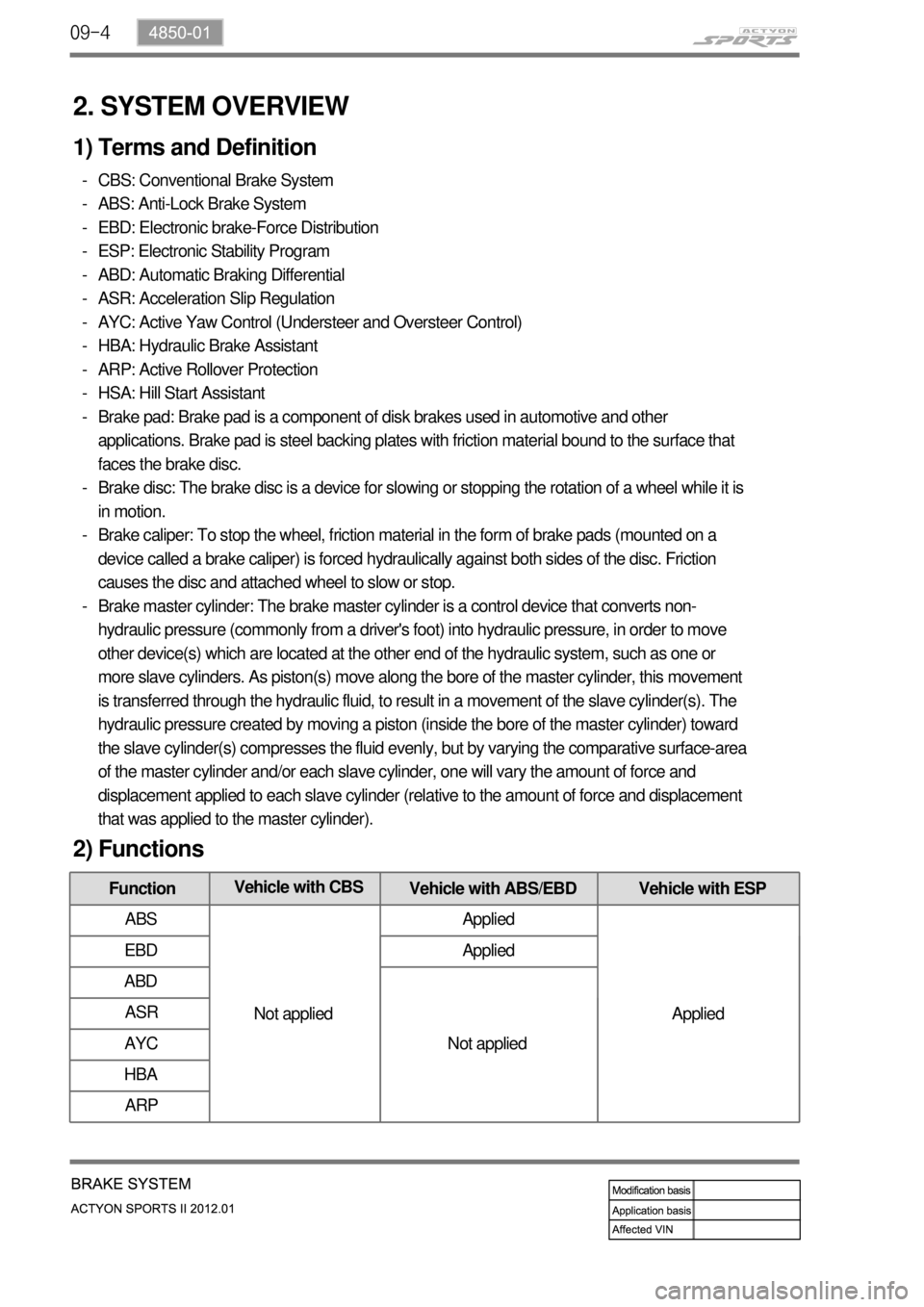brake pads SSANGYONG NEW ACTYON SPORTS 2012 Service Manual
[x] Cancel search | Manufacturer: SSANGYONG, Model Year: 2012, Model line: NEW ACTYON SPORTS, Model: SSANGYONG NEW ACTYON SPORTS 2012Pages: 828, PDF Size: 91.28 MB
Page 652 of 828

09-4
2. SYSTEM OVERVIEW
1) Terms and Definition
CBS: Conventional Brake System
ABS: Anti-Lock Brake System
EBD: Electronic brake-Force Distribution
ESP: Electronic Stability Program
ABD: Automatic Braking Differential
ASR: Acceleration Slip Regulation
AYC: Active Yaw Control (Understeer and Oversteer Control)
HBA: Hydraulic Brake Assistant
ARP: Active Rollover Protection
HSA: Hill Start Assistant
Brake pad: Brake pad is a component of disk brakes used in automotive and other
applications. Brake pad is steel backing plates with friction material bound to the surface that
faces the brake disc.
Brake disc: The brake disc is a device for slowing or stopping the rotation of a wheel while it is
in motion.
Brake caliper: To stop the wheel, friction material in the form of brake pads (mounted on a
device called a brake caliper) is forced hydraulically against both sides of the disc. Friction
causes the disc and attached wheel to slow or stop.
Brake master cylinder: The brake master cylinder is a control device that converts non-
hydraulic pressure (commonly from a driver's foot) into hydraulic pressure, in order to move
other device(s) which are located at the other end of the hydraulic system, such as one or
more slave cylinders. As piston(s) move along the bore of the master cylinder, this movement
is transferred through the hydraulic fluid, to result in a movement of the slave cylinder(s). The
hydraulic pressure created by moving a piston (inside the bore of the master cylinder) toward
the slave cylinder(s) compresses the fluid evenly, but by varying the comparative surface-area
of the master cylinder and/or each slave cylinder, one will vary the amount of force and
displacement applied to each slave cylinder (relative to the amount of force and displacement
that was applied to the master cylinder). -
-
-
-
-
-
-
-
-
-
-
-
-
-
FunctionVehicle with CBS
Vehicle with ABS/EBD Vehicle with ESP
ABS
Not appliedApplied
Applied EBD Applied
ABD
Not applied ASR
AYC
HBA
ARP
2) Functions
Page 674 of 828

09-26
1. OVERVIEW
Even though a driver cuts off the power, while driving, the vehicle continues to move due to the
law of inertia. Therefore, a braking device is needed to stop the vehicle. The brake system
normally uses the frictional discs that converts the kinetic energy to the thermal energy by
frictional operation. The brake system consists of the brake disc (front wheel), brake disc or drum
(rear wheel), parking brake (mechanical type), master cylinder, booster, pedal and supply lines
(pipes and hoses).
Hydraulic Brake ▶
Brake Pedal ▶This system uses the leverage effect and
Pascal's principle. When depressing the
brake pedal, the pedal pressure is increased
by booster and is delivered to master cylinder
to generate hydraulic pressure. The hydraulic
pressure generated by the master cylinder is
delivered to the brake caliper through the
brake pipes or hoses. This hydraulic pressure
pushes the brake calipers, accordingly the
caliper pads are contacted to brake disc to
generate the braking force.
Brake pedal uses the leverage effect to apply
bigger force to the brake master cylinder.